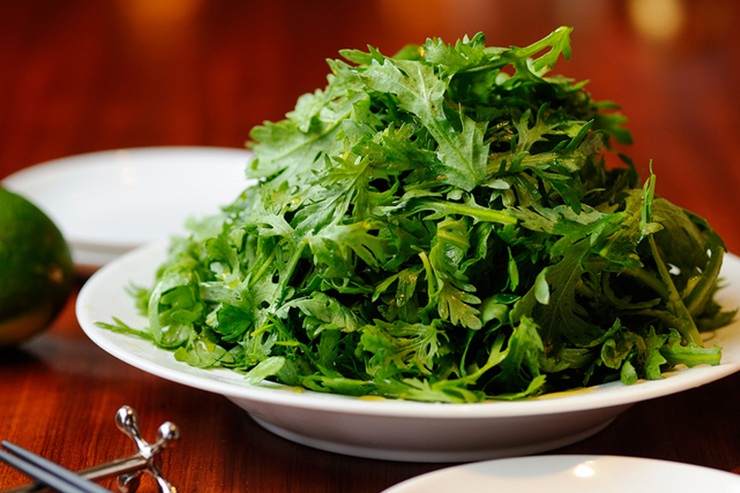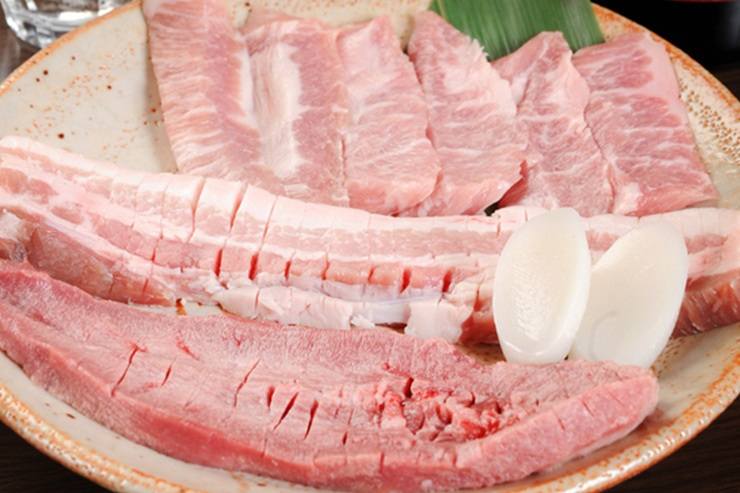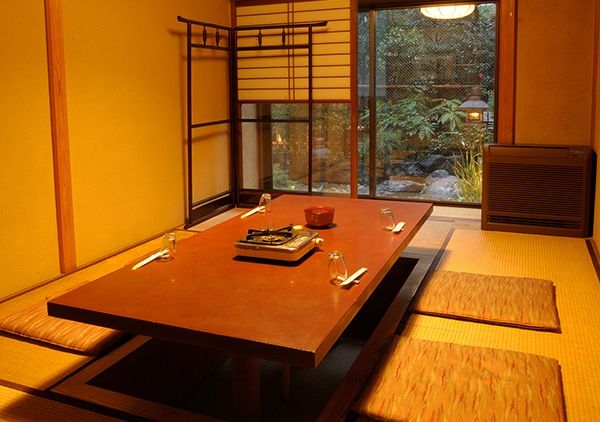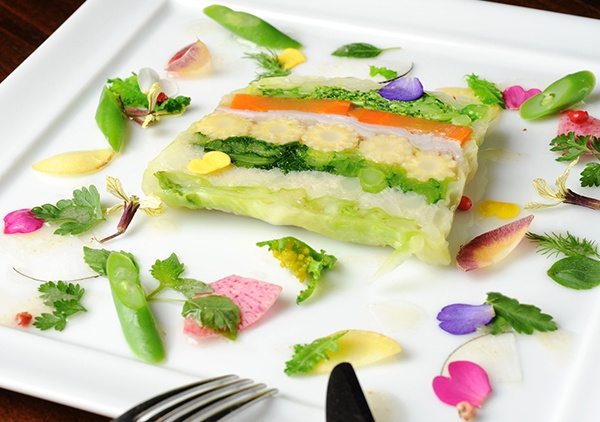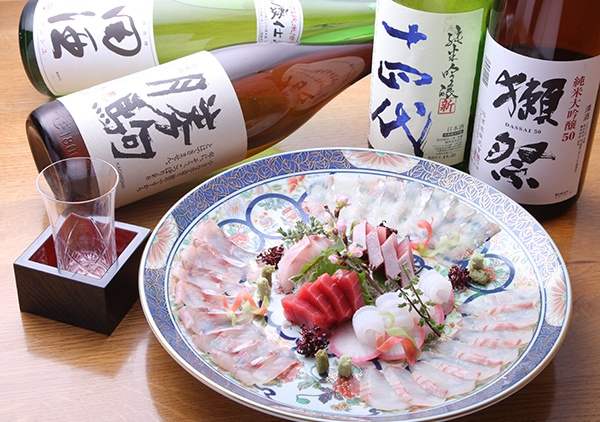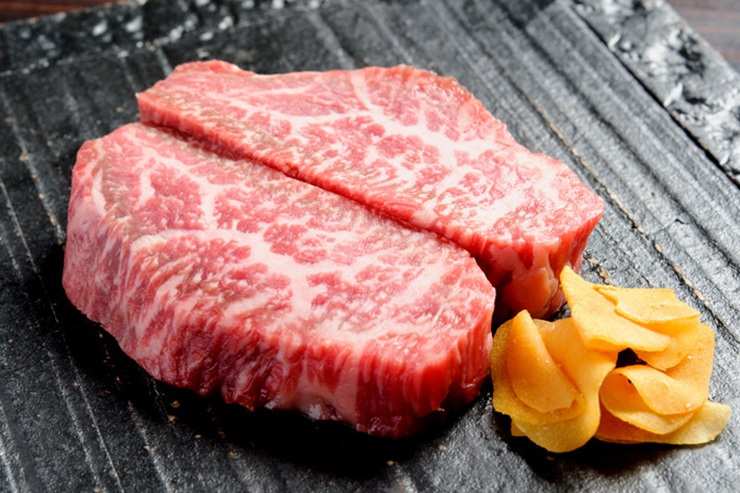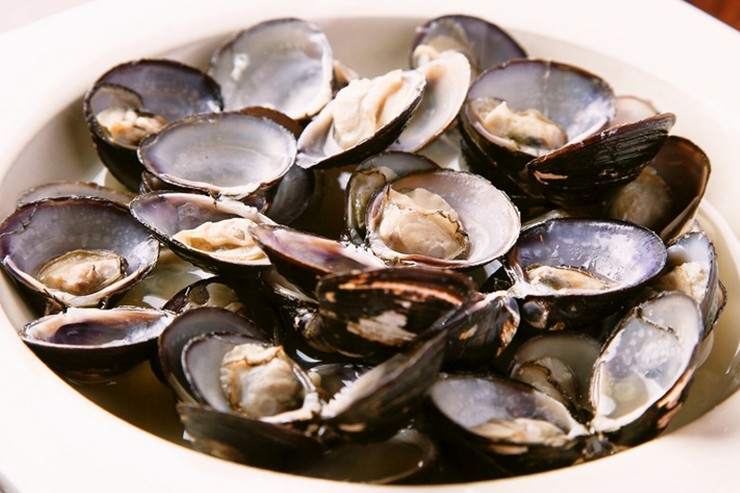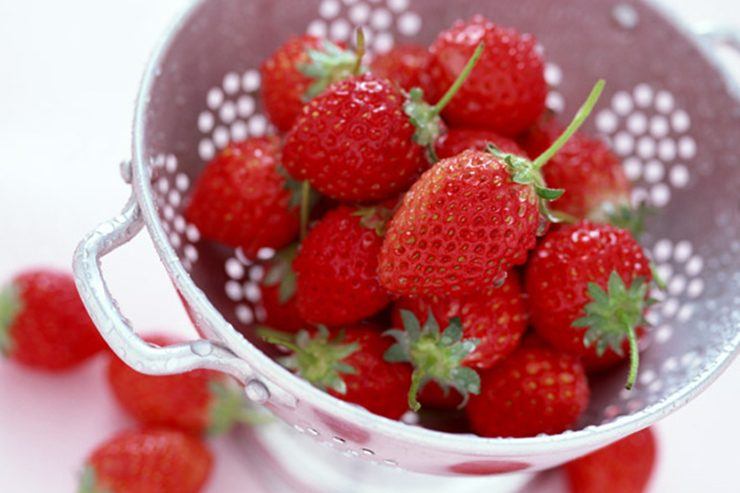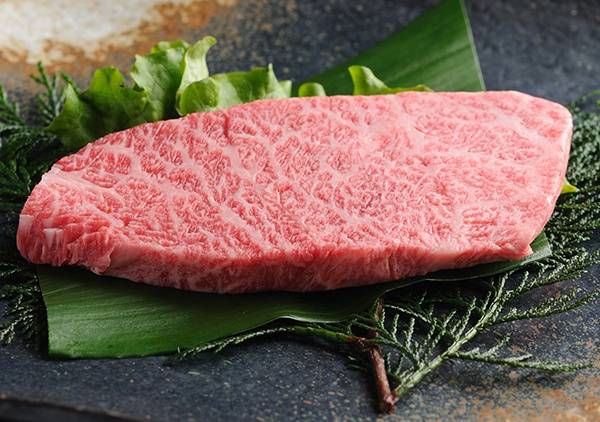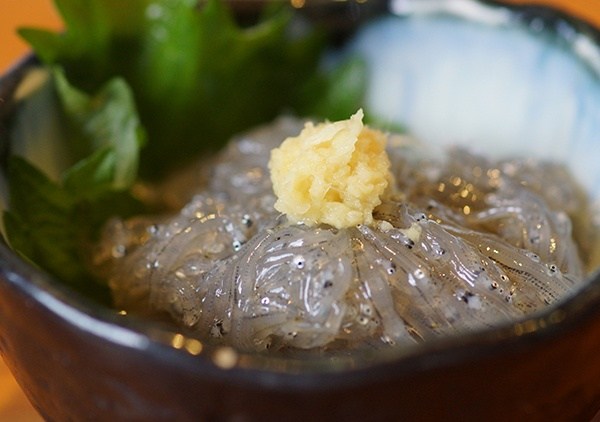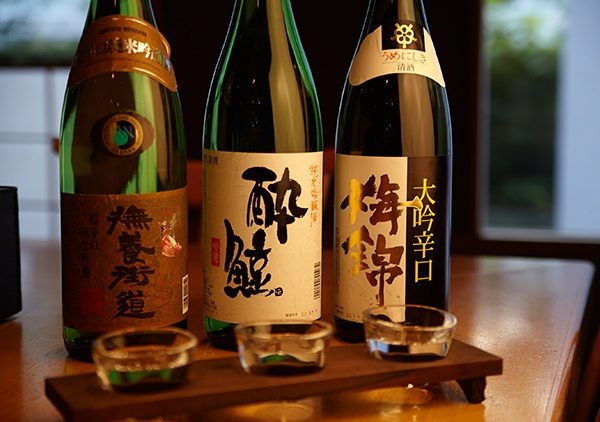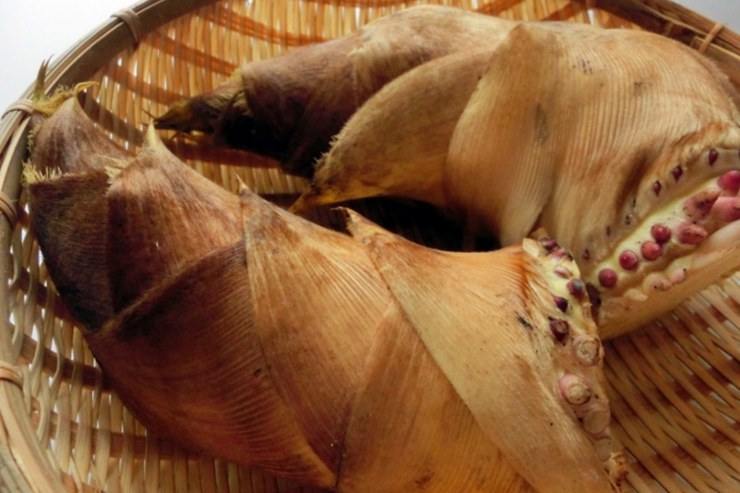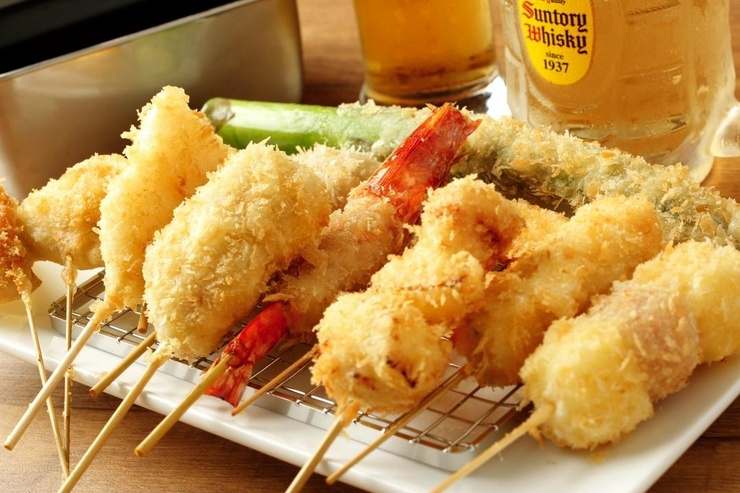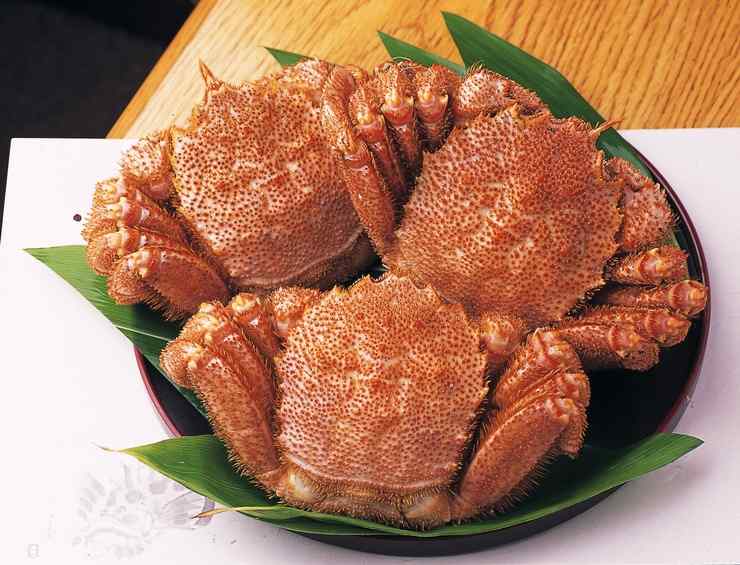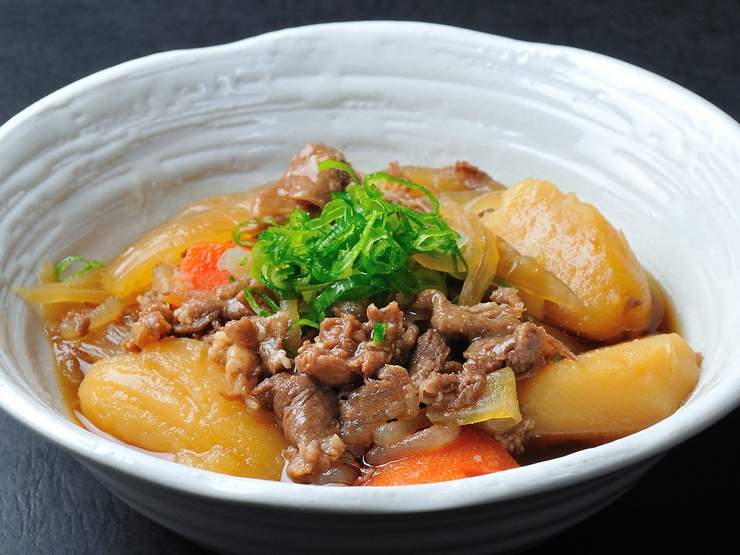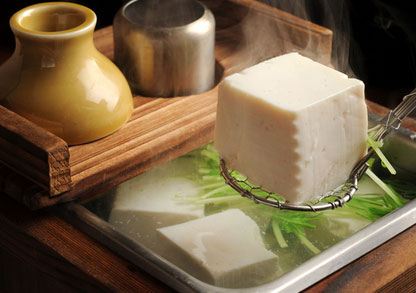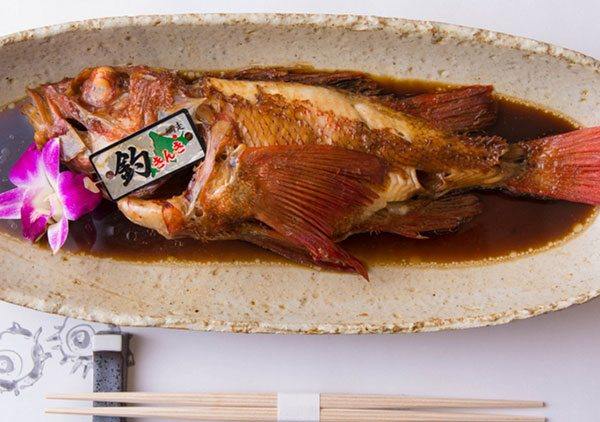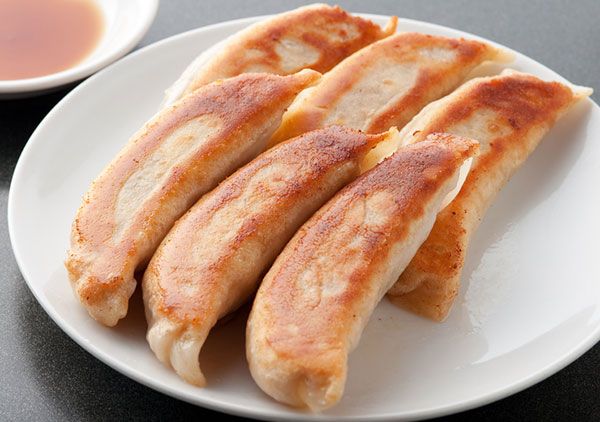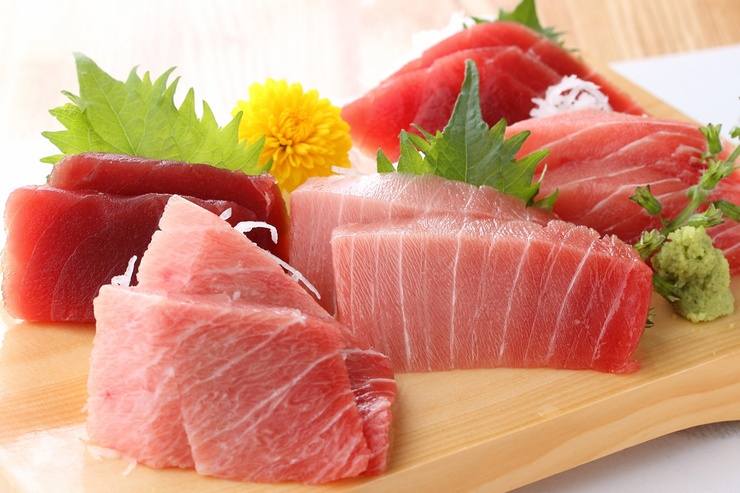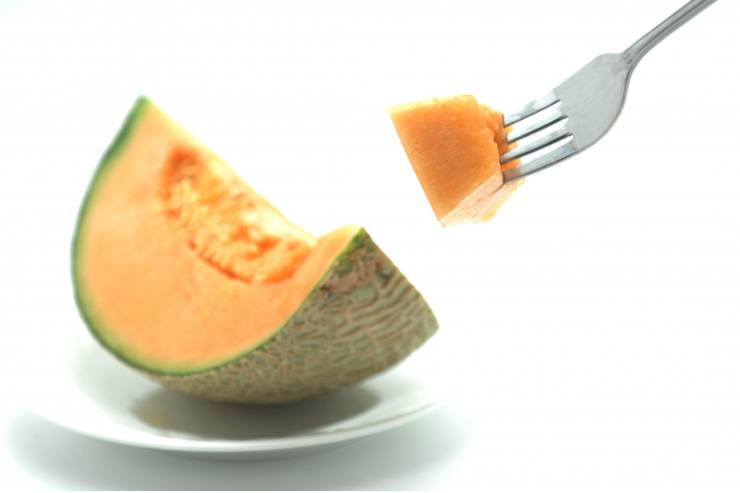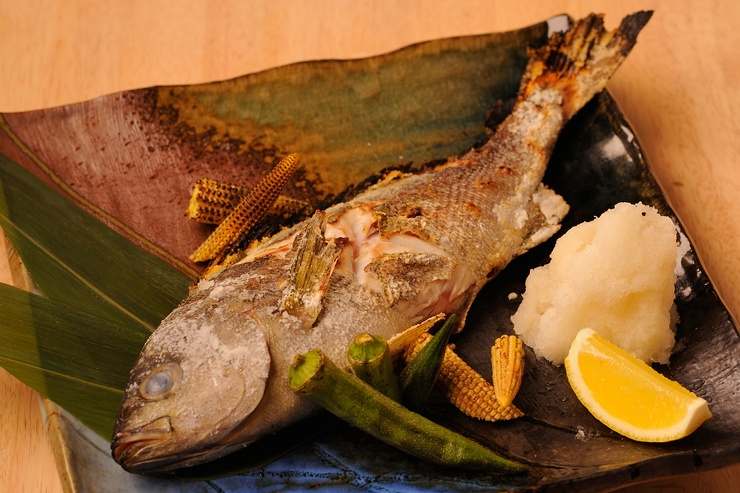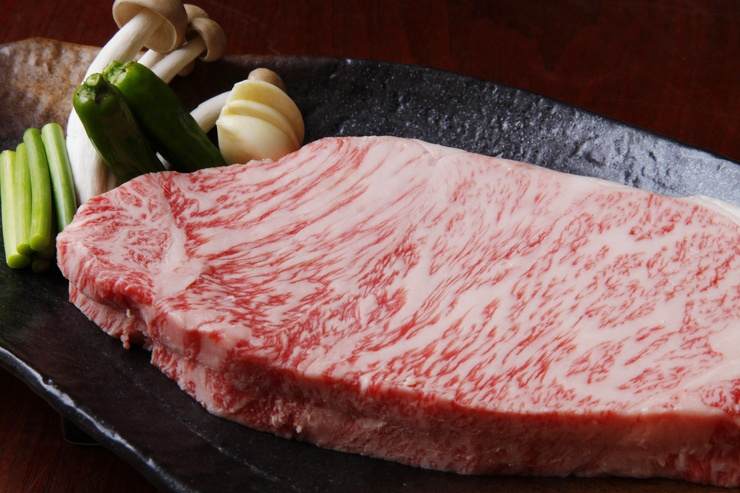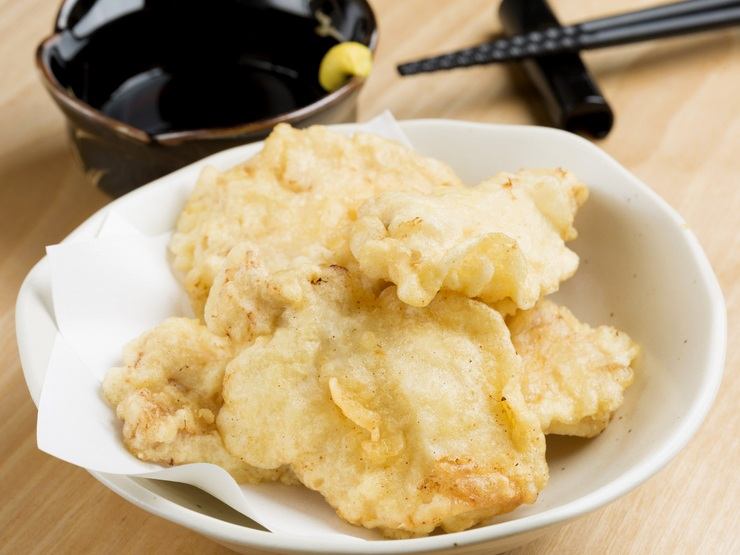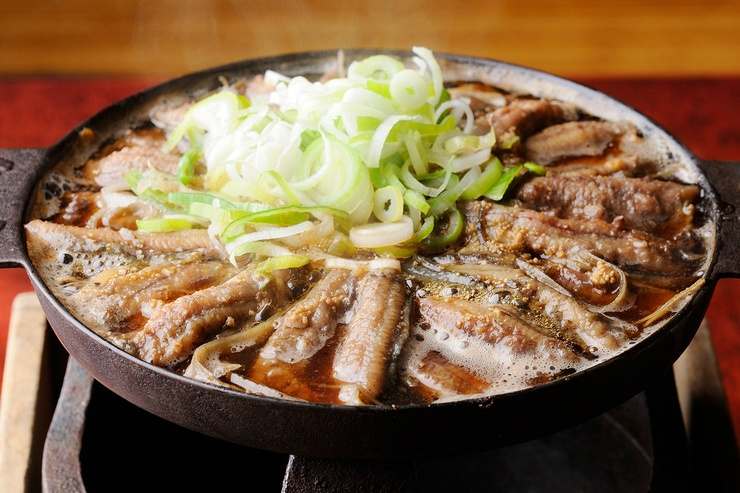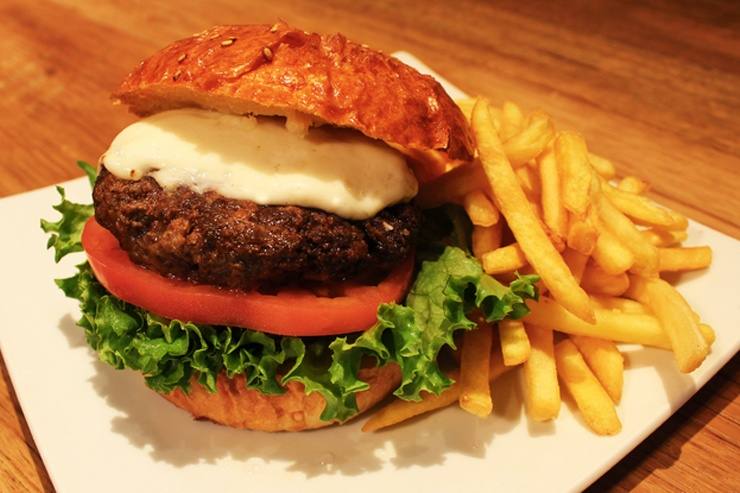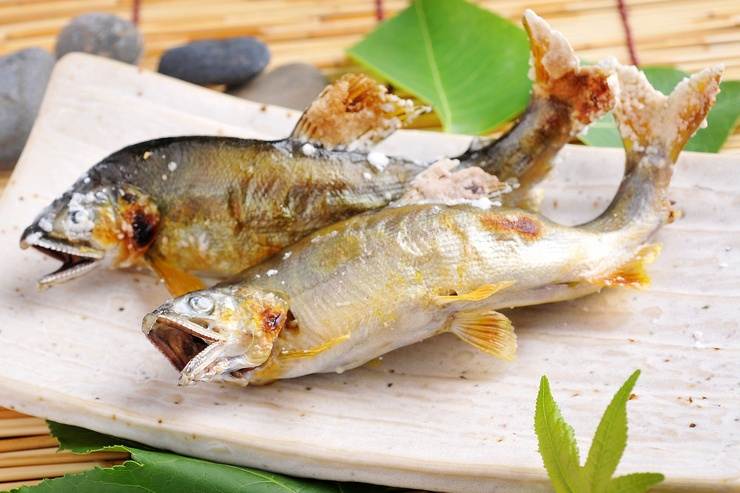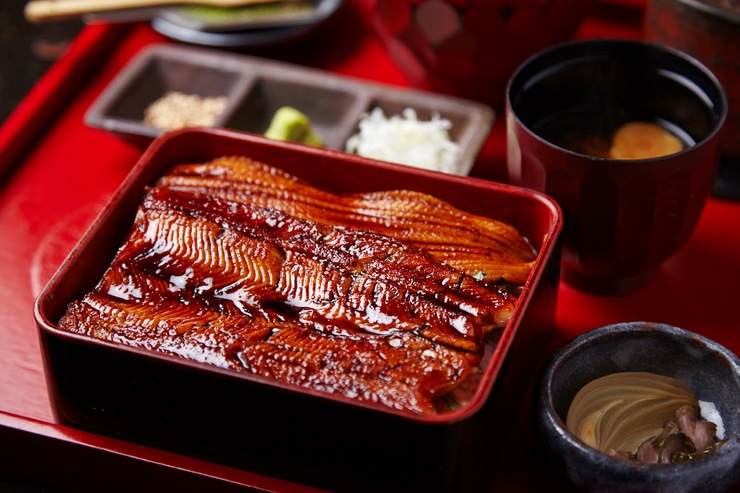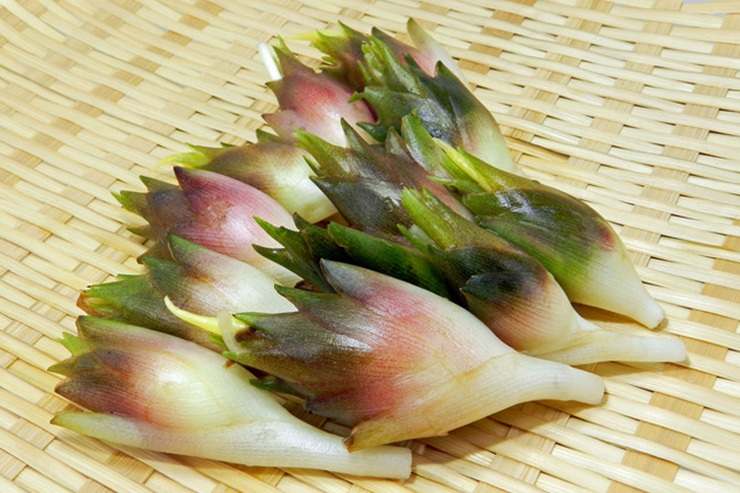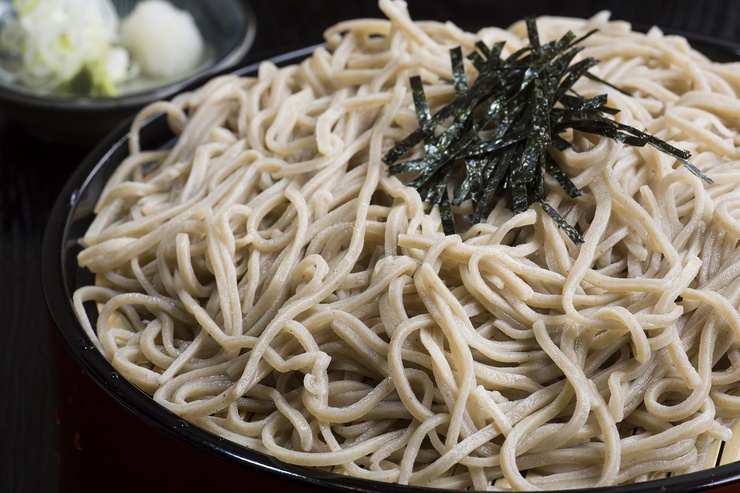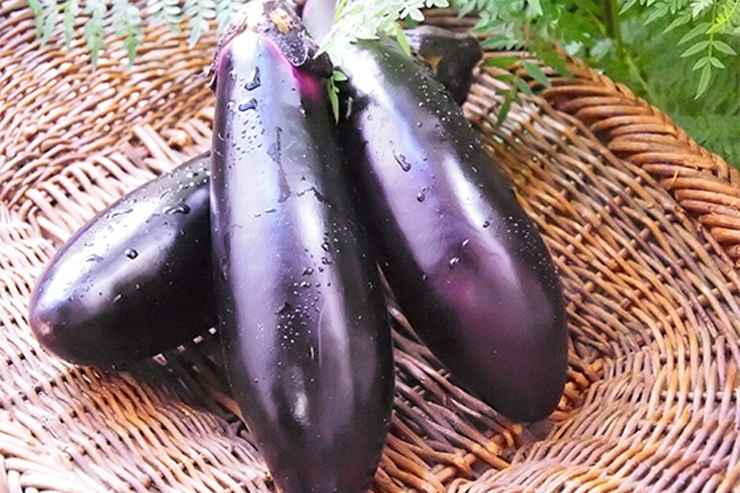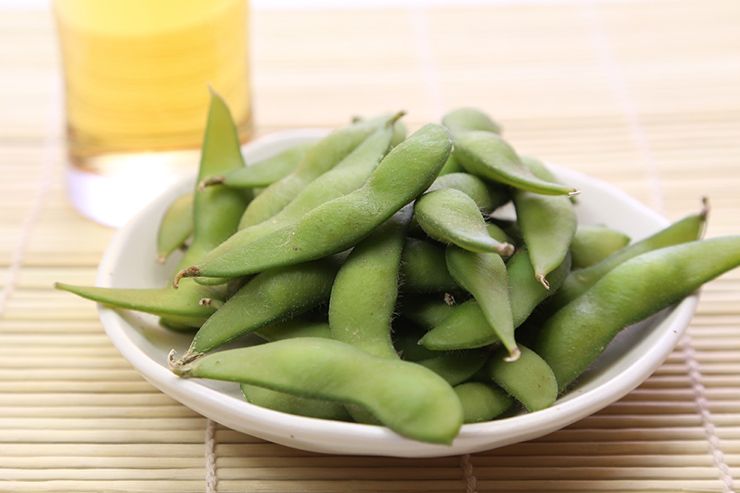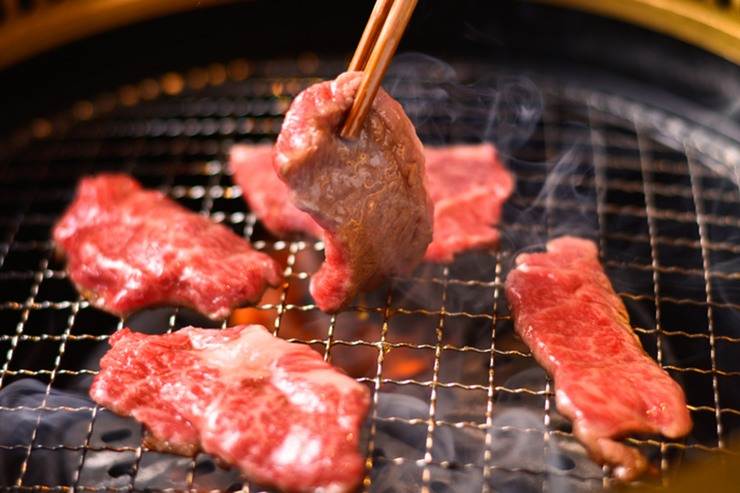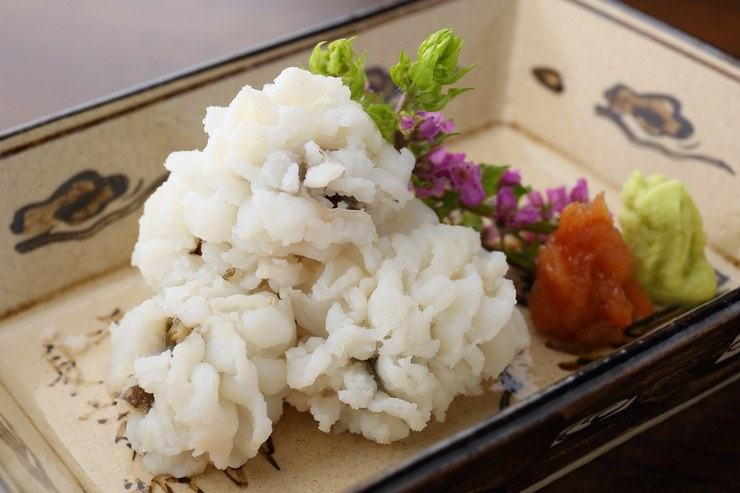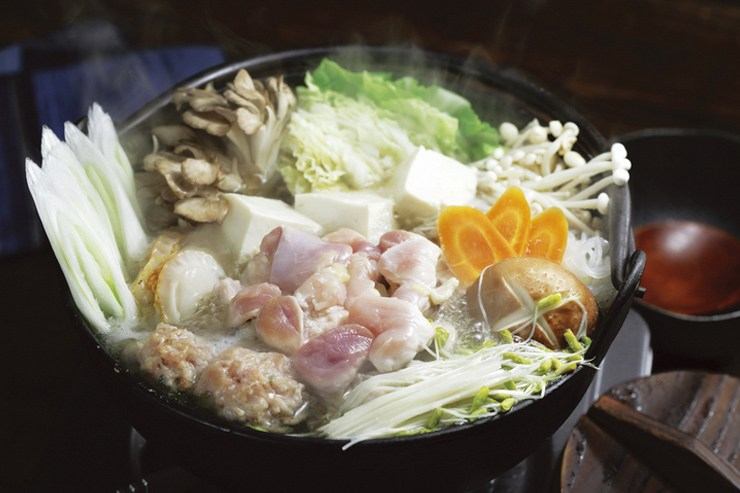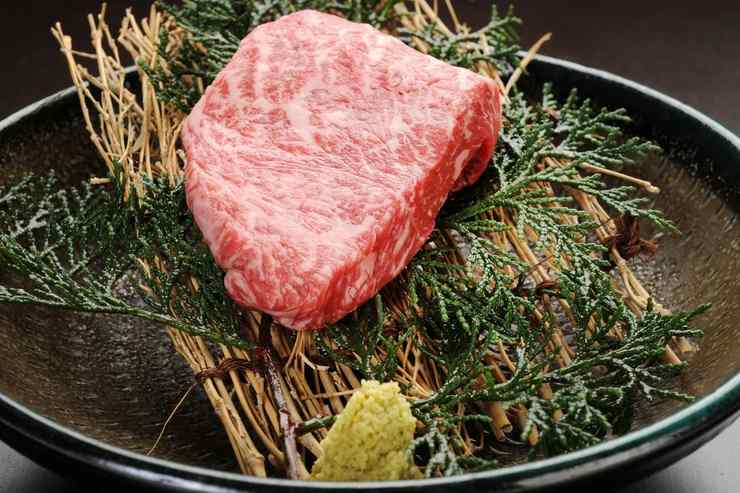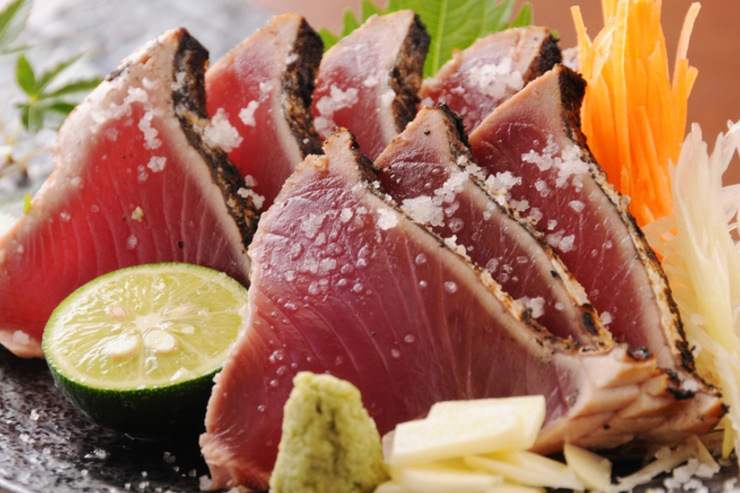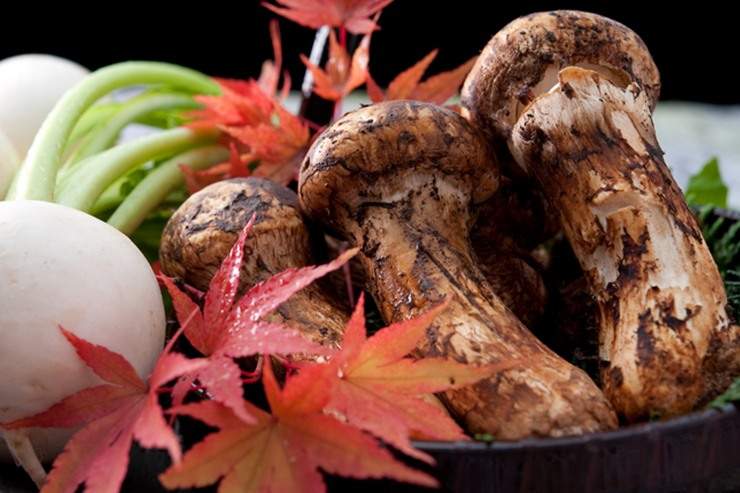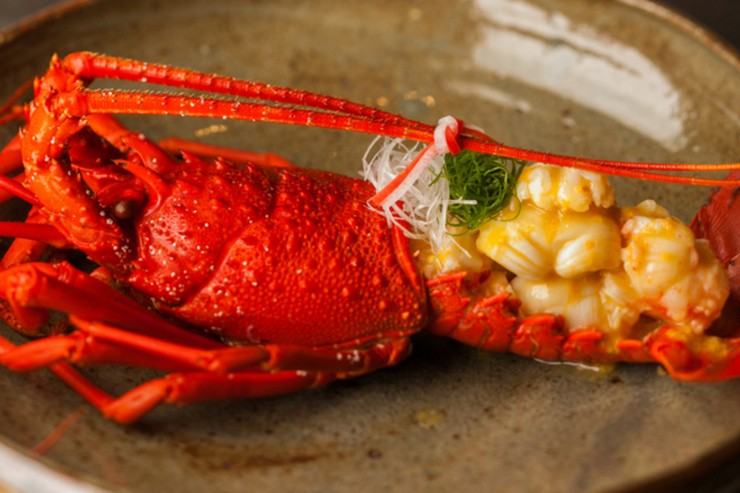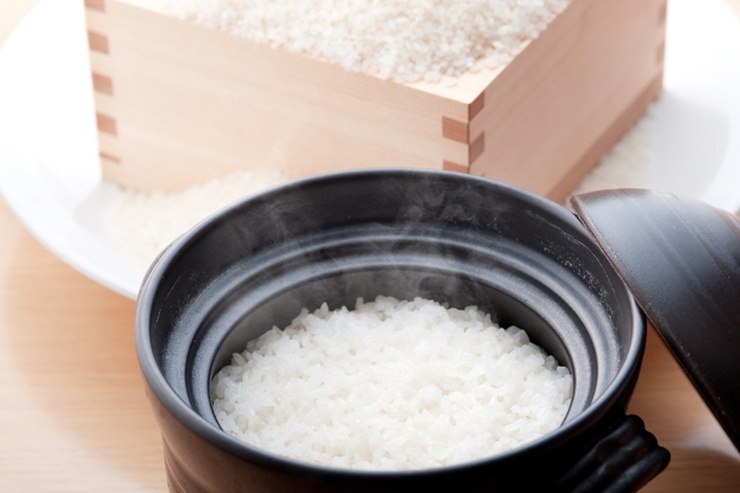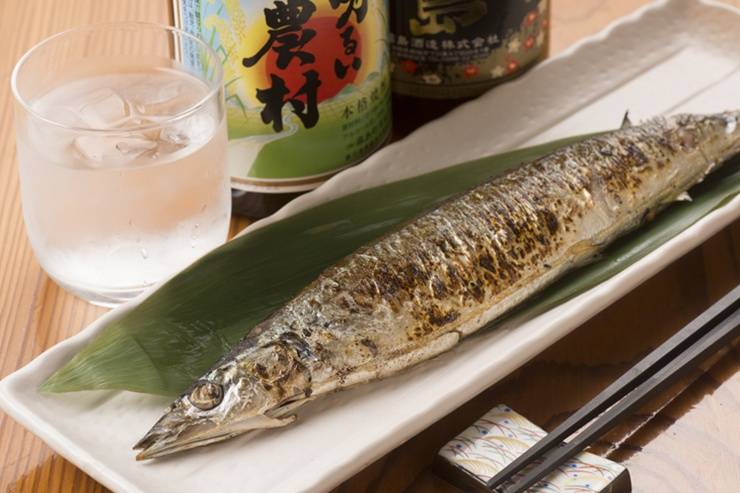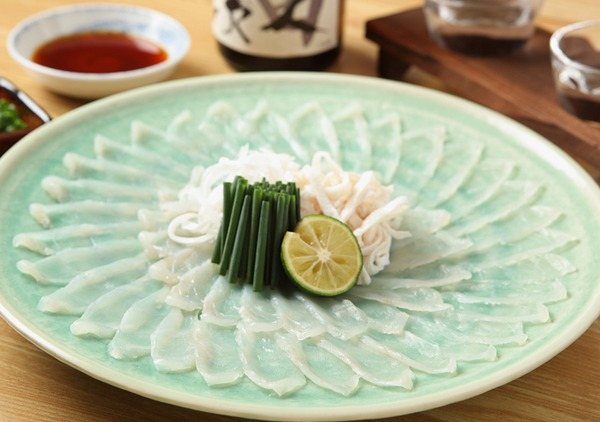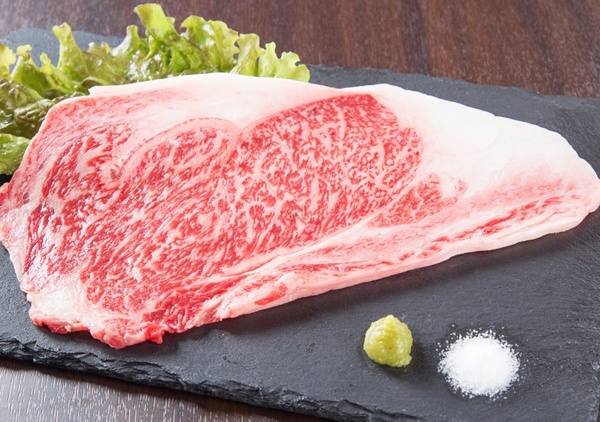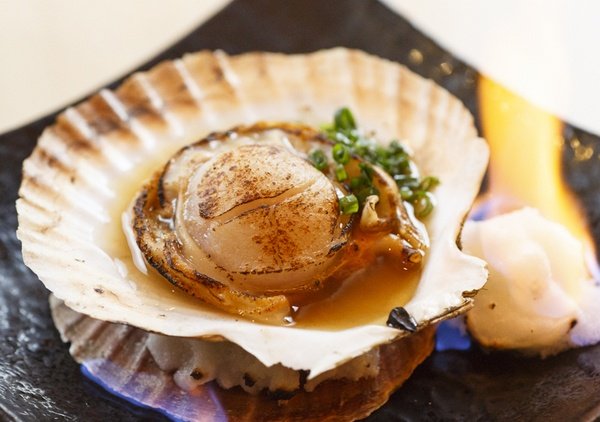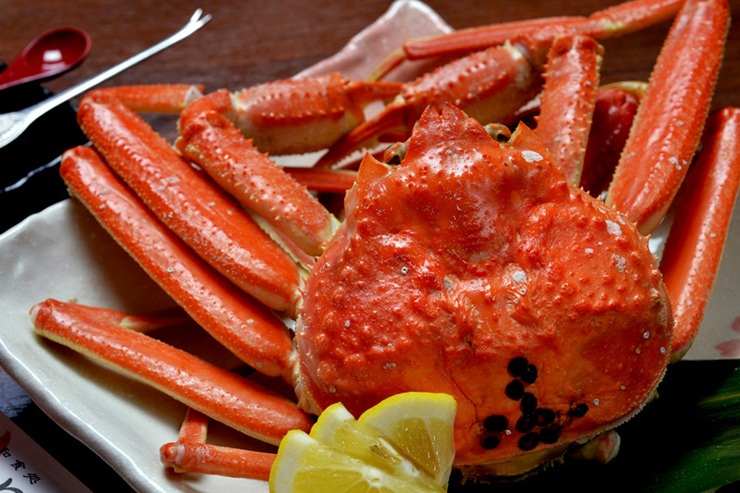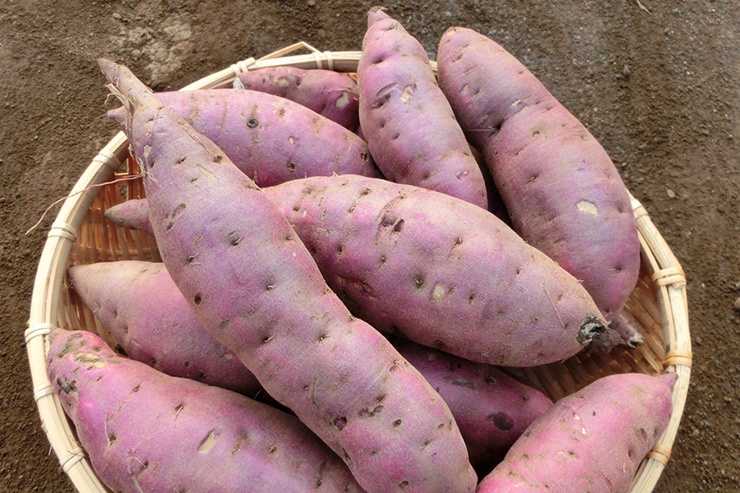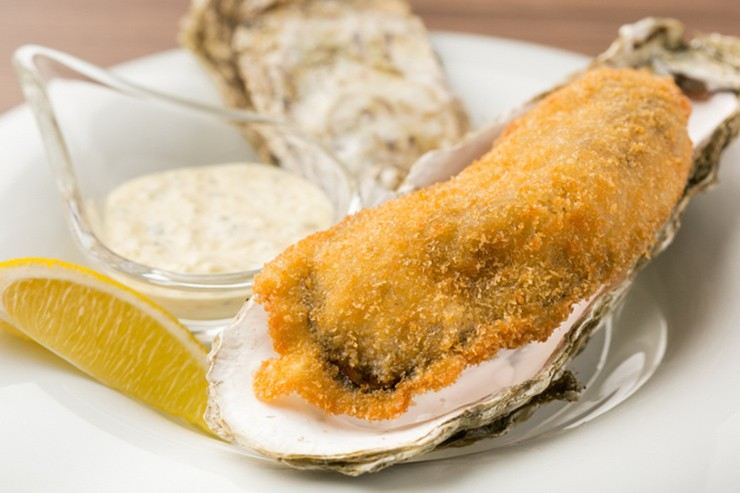On the menu
Archive
January
Clam
-
02.01.2016
Great things come in pairs - of clamshells
-
Tender hamaguri clams redolent of wide-ranging coastal waters spawn from May to October, and are most delectable from February to April. As customary treats for Hinamatsuri (Doll Festival celebrating girls' growth every March 3), they give celebrants fine reasons to feel lucky. Served in soup at wedding parties, hamaguri are eternal symbols of fufu wago (marital harmony) for couples that hope to be as naturally compatible as the pair of shells that contain their distinctive delicacy.
Chrysanthemum Leaves
-
02.01.2016
Crunchy chrysanthemum greens for a fresh sense of spring
-
Whoever invented the Chinese character for both Epring Eand ‘chrysanthemum Elikely considered those subjects inseparable after experiencing the delightful smell and taste of fresh shungiku chrysanthemum greens blooming as the weather warmed. Now, various kinds of shungiku grow from November to March in Japan, lending fresh crunch and astringent taste to sukiyaki, fugu (blowfish) nabe and other hot pot dishes, stir fries, fresh salads and tempura.
Hakkinton pork
-
02.01.2016
Creamy, delectable Hakkinton pork* more precious than platinum
-
What makes Hakkinton (or platinum) pork one of the finest breeds of pork? Pigs carefully bred and raised on sprawling farms in the natural environs of the Ouu mountain valley in the town of Hanamaki, Iwate Prefecture. A diet rich in minerals and spring water. Beautiful marbling for buttery soft, smooth texture. Delectably fragrant, mildly sweet flavor. No wonder seasoned gourmets around the world love it for tonkatsu deep-fried cutlets, shabu shabu hot pots, roast pork and other meaty dishes.
* A product of Takagen Seibaku Co., Ltd.
Japanese spring vegetables
-
02.02.2015
Dine like a gourmet on fresh Japanese spring vegetables only available in Japan.
-
Fragrant early spring Japanese vegetables sprout vivid green and are rich in nutrition as well as tasty. Start with the distinctive aroma and texture of udo (aralia cordata). Move on to nanohana (field mustard), symbolic of spring's awakening. And don't forget sweet, tender spring cabbage...
Japan's quintessential seafood
-
02.02.2015
Savor the catch of the season - Japan's quintessential seafood.
-
In Japan, they say, "those who eat seasonally live well and long". Early spring catches include cod with pale-as-snow flesh and a delicate flavor in nabe (hot pot) dishes, Sayori (halfbeak) perfect for tempura (deep fried), and Hobo (sea robin) salted and grilled or sliced as sashimi.
February
February
2016
Tajima beef
-
02.26.2016
Tajima beef from Hyogo Prefecture
-
Various brands of beef, including world-renowned Kobe beef, are derived from Tajima cattle, a breed of kuroge-wagyu (Japanese black cattle) raised in Hyogo Prefecture. Its meat is finely marbled with fat that has a low melting point and literally melts in your mouth. Only the finest beef meeting the most stringent standards of the Kobe Beef Marketing and Distribution Promotion Association is certified as Tajima beef. Whether grilled as steak or finely ground in hamburger, it tastes light and delicious. Be sure to try Tajima beef when visiting Japan!
Freshwater Clam
-
02.26.2016
The hangover cure that comes in a shell. Shijimi.
-
When Japanese have morning hangovers, they typically consume shijimi (freshwater clams) to ward off the effects. The clams, available at supermarkets throughout Japan, contain amino acids (ornithine) that help detoxify ammonia, reduce fatigue and protect the liver. Too small to eat separately, they are usually added to miso soup to enhance its flavor. When eaten at restaurants, they give you the confidence to drink more alcohol without worrying about the next morning.
Strawberry
-
02.26.2016
Sweet and aromatic spring strawberries
-
Japanese strawberries are sweet, juicy and richly flavorful. This is especially true between March and May when the fruit is most delicious.
They are most commonly grown in Tochigi, Fukuoka, Kumamoto and Nagasaki prefectures, where berry picking in greenhouses is a popular pastime. Glossy Japanese strawberries are typically eaten plain in Japan, but are also added to cakes and various sweets. If you find yourself in Japan during the spring season, why not put strawberry picking on your to do list!
2015
Kobe beef
-
02.27.2015
Premium Japanese Kobe beef. A delicacy beyond compare.
-
Unbelievably tender and flavorful, beautifully marbled Kobe beef is only available from Tajima cattle meeting the most stringent standards. At least once in your life, you must experience the rich umami (savory flavor) as Kobe beef literally melts in your mouth. Whether served as steak, sukiyaki or shabu shabu, you will never forget the experience.
seabream and whitebait
-
02.27.2015
Early spring - the season for cherry blossoms, seabream and whitebait.
-
When cherry trees bloom pink, seabream don the same color and become their smooth, fatty best. They are even renamed sakuradai (cherry blossom seabream) during this metamorphosis. Additioanlly, whitebait pleases the plate with seasonal creamy sweetness. It is also delicious as crispy tempura.
Large sake selection
-
02.27.2015
Explore the surprisingly diverse flavors of Japanese sake.
-
Spring is in the air, making it the right time to relax and enjoy Japanese sake. But selecting the right brand of sake can be challenging when there are numerous choices. So be sure to ask the proprietor, waiter or bartender for advice on the brand that best matches your meal or mood. Or better yet, try a sampler set and decide for yourself. At many establishments, they will write down the names of the brands for you so you remember your favorites the next time!
March
March
2016
Bamboo Shoot
-
03.28.2016
Takenoko EFeast on fresh bamboo shoots of spring
-
The best time to enjoy bamboo shoots (takenoko) grown in the mountains is in spring, between April and May. Especially for Japanese cuisine prepared to capture the tastes of food at the height of their respective seasons, it is essential that takenoko are fresh. Ideally, the shoots should be boiled and eaten on the day that they are dug out of the ground, as their taste becomes coarser over time. Although boiled bamboo shoots packaged in water can be found at shops throughout the year, nothing beats the great taste and tenderness of just-harvested spring bamboo shoots. Cooked with rice (takikomi gohan), simmered in broth, or added to other dishes, you’re certain to marvel at the versatility and quality of this delightful ingredient.
Mebaru
-
03.28.2016
Mebaru - Rockfish is delicious from every angle in springtime
-
When it’s time for the start of early spring sea fishing season in Japan, rockfish (mebaru) are among what fishermen go for first.
Prized among anglers, rockfish have eyes ("me" in Japanese) nearly half the size of their heads and are named for their tendency to stay near rocks, which can make them difficult to catch. The delicate flesh of this popular, versatile fish has a mild, simple flavor that’s delicious when simmered in soy sauce, sugar and sake, grilled with salt, deep fried, or prepared in other ways.
Enjoy mebaru however you like Eit is sure to impress upon people that you’re familiar with fresh Japanese cuisine.
Fuki
-
03.28.2016
Fuki - Add spring to your taste with Japanese butterbur vegetable appetizer
-
Fuki are edible, approximately meter-long stalks of the butterbur plant that is native to Japan, China and Korea. In Japan, the plant thrives around streams and in woodlands as well as other soggy soil from Hokkaido to Kyushu, but mostly in Aichi prefecture. Succulent fuki is best harvested at its height from spring to early summer. Marinating or cooking it in broth for the kyarabuki variety of tsukudani (preservable appetizers made by simmering such ingredients as seafood, seaweed, meat and vegetables in mirin and soy sauce) softens its faint bitterness into a distinctive, even pleasantly addictive epicurean sensation.
March
2015
Kushiage
-
03.30.2015
Enjoy kushiage - hot crispy fried seasonal fast food from western Japan
-
Kushiage (also known as kushikatsu), a Japanese dish of bite-sized pieces of meat, vegetables, fish and shellfish deep fried on a bamboo skewer (kushi), originated from a counter-style eating stand in downtown Osaka in western Japan. Some of the most cherished kushiage eateries have their own recipes (closely, eternally guarded secrets) for the sauces that make this comfort food even more comforting.
Kegani
-
03.30.2015
Calling all crab lovers! Have you had the pleasure of eating Japan's kegani?
-
Kegani (hairy crab or horsehair crab) from Hokkaido in northern Japan is a renowned Japanese specialty that you can loudly crack open, eat with gusto, and feel great about, especially since it is low in calories, yet rich in protein, vitamin B12, minerals and amino acids.
Nikujyaga
-
03.30.2015
Spring is high season for savoring potatoes and nikujyaga - Japanese soul food!
-
Nikujyaga exemplifies Japanese home cooking with its hearty combination of meat, potatoes, onions, carrots and other vegetables stewed in sweetened soy sauce. If the way to a man's heart is through his stomach, then single Japanese women have certainly prepared it with love and shin jyaga (spring's "new potatoes") to keep their partners coming for more.
Tofu
-
03.13.2015
Authentic Japanese tofu, served the traditional way in Kyoto.
-
Japanese tofu is popular worldwide thanks to its soft texture, subtle flavor, low calories and numerous health benefits. It is typically made by adding a natural coagulant called nigari (magnesium chloride) to strained soy milk and then pressing the resulting curds. While there are dozens of delicious ways to serve Japanese tofu, we recommend trying yudofu (simmered tofu) made the traditional way in Kyoto, a city historically obsessed with tofu.
Nizakana
-
03.13.2015
Nizakana. One of Japan's favorite recipes for seasonal fish.
-
Almost any fish tastes delicious when prepared as nizakana, which is simmered in dashi and soy sauce. In spring, ocean perch, mackerel and spear squid are especially popular choices. The meat becomes soft yet firm, with a sweet smell from the dashi that removes any trace of fishiness. Nizakana is one of most common home-made dishes in Japan, and its thick sauce goes extremely well with white rice.
Yakigyoza
-
03.13.2015
Irresistible Yakigyoza, Japan's sauteed version of Chinese dim sum.
-
In China, dim sum (pork dumplings) are served boiled. But Japan takes a similar recipe and quick fries it to create a crispy treat with juicy center and garlic aroma that is perfect for savoring with beer. Yakigyoza is extremely popular throughout Japan and there are countless gyoza specialty shops lining the streets. It's often served as a side dish with ramen and like many Japanese, you may find it addictive.
April
April
2016
Tuna
-
04.27.2016
Maguro. Japan's best-loved sashimi.
-
Deep-sea fishing vessels chase maguro (tuna) around the world to meet demand throughout the year in Japan. Maguro is also caught more locally off the coast of Japan in the spring and summer. At any time of the year, we recommend trying various cuts of maguro. The most sought-after part is the rich and fatty belly, called otoro (fatty tuna), which is somewhat expensive. The firmer, reddish akami (lean) and chutoro (medium‐fatty tuna) are also flavorful and quite popular. More uncommon parts worth trying include the cheek and top of the head. Why not try them all and discover your favorite part! Tuna in Japan is generally eaten as sashimi or sushi, but some parts are best enjoyed simmered or grilled with salt.
Melon
-
04.27.2016
The fruit with a juicy price tag. Melon.
-
Various types of melon are grown in Japan. The king is Yubari melon, a brand from Hokkaido with incredibly sweet and delicious bright-orange flesh. Yubari melon and other brand melons certified by the Ministry of Agriculture are expensive and typically purchased for use as fancy gifts. You can sometimes find them at reasonable prices in supermarkets, but they are generally sold at first-class fruit shops. Melon pan (sweet bun with melon-like crust) and bright green melon soda are also popular in Japan. Both are delicious and worth trying, but be forewarned that neither tastes at all like melon.
Isaki
-
04.27.2016
Light tasting and luxurious in summer. Isaki.
-
The best season for isaki, known as grunt, is late spring to summer. These delicious white-flesh fish follow the warm Kuroshio Current and are mainly caught off the coast of southern Japan. When served as sashimi, their white meat has a rich flavor like tai (sea bream). They can be simmered or grilled to intensify the flavor, and are perfect for frying and meuniere as well. Isaki comes to market at the end of spring and early summer and is commonly sold during tsuyu (rainy season). Gourmets grill them with salt and eat them with cold sake to lift their spirits during the damp rainy season. You can find isaki at restaurants that serve set meals and at izakaya (taverns) near markets.
April
2015
Hidagyu
-
04.27.2015
Enjoy beautifully marbled Hidagyu, Japan's best beef for steak.
-
Hidagyu (Hida Beef) is one of the finest varieties of Wagyu (Japanese beef). Other renowned Wagyu varieties include Matsuzaka beef, Kobe beef and Oumi beef. The name Hidagyu only applies to extremely high-quality beef from black-haired Japanese cattle that was raised in Gifu Prefecture for at least 14 months and graded class 5, 4 or 3 by the Japan Meat Grading Association. In 2002, Hidagyu was crowned the best beef in Japan at the 8th "Olympics of Wagyu", which is held every five years.
Toriten
-
04.27.2015
Delicious Toriten "chicken tempura" from Oita. Perfect with Japanese sake.
-
Karaage is the most common type of fried chicken in Japan. But there is a similar dish called Toriten that is also quite popular. Toriten chicken is battered and deep fried like tempura, while Karaage chicken is coated with flour or potato starch and fried in light oil. Karaage is sometimes eaten with mayonnaise, whereas Toriten is almost always eaten with mustard or ponzu sauce made from soy sauce, vinegar and Japanese citrus fruit. According to rumors, Toriten is so popular in Oita Prefecture, Kyushu (where it originated) that it once put a certain American fast-food fried chicken restaurant out of business in the area.
Amaebi shrimp
-
04.27.2015
Melt your heart with the soft texture and sweetness of Amaebi shrimp.
-
Sweet Amaebi shrimp herald the arrival of spring in Hokkaido. Unlike other shrimp, they are best enjoyed raw because cooking diminishes their sweetness. Light pink when fresh, they are commonly served as sashimi or sushi. Their heads may be included as decoration or added to miso soup to enhance its flavor. Amaebi eggs, seasonal in spring, are also a delicacy in Japan.
May
May
2016
Dojyo
-
05.31.2016
Dojo (loaches) for summertime stamina.
-
Dojo (loaches) are small but highly nutritious fish eaten in Japan since the Edo era. While not commonly seen on family dinner tables any more, they can be found at restaurants specializing in dojo. Like eel, dojo are eaten as stamina food in the summer. But they have a lighter, more bitter flavor and are served whole, rather than cut open. We especially recommend trying them in Yanagawa-nabe (hot pot), but they are also delicious when deep fried or served as Namban-zuke (fried and marinated with sweet vinegar and peppers) for refreshment. Eaten with a cup of sake, they will make your day!
Hamburgers
-
05.31.2016
MADE IN JAPAN hamburgers original, and only available in Japan!
-
Japanese love hamburgers just like everyone else. There are fast food chains and independent restaurants serving hamburgers throughout the country. And many offer original variations of hamburger found only in Japan. You can find expensive hamburgers made from Kobe or Hida brand beef, burgers topped with teriyaki (sweetened soy) sauce, burgers sandwiched between patties of rice and more. It's another great reason to visit Japan.
Ayu
-
05.31.2016
Ayu. Japan’s sweet river fish.
-
When summer arrives, many Japanese go river fishing for ayu (sweetfish), which has a sweet, distinctive flavor and a refreshing, prized scent that earns the fish its kougyo (aromatic fish) nickname. Catching ayu is prohibited from November to May, as a measure to protect the species, but becomes legal from June when the skin and bones of waka-ayu (young ayu) are especially soft. Ayu breed in late autumn and their larvae are carried to sea to grow before returning to rivers in warmer weather. Why not follow Japanese tradition and kick off your summer with sweet and tasty ayu!
May
2015
Anago
-
05.29.2015
Unagi's distant cousin, anago. Everybody's favorite eel.
-
Anago (conger eel) dwell at the bottom of the sea in sandy holes (ana) from which their name was derived in the Edo era (1603-1867). Usually 30 to 40cm long when harvested, they can grow to 90cm in length. Unlike unagi (freshwater eel) that are born in seawater but migrate to fresh water, anago spend their entire lives in the ocean. They are also cheaper and less oily than unagi, contributing to their widespread appeal. Rich in vitamins A and E, anago are best enjoyed in the summer. They are commonly skewered and grilled over an open fire (kabayaki), served in nigiri sushi, or prepared as tempura and served on bowls of rice (tendon).
Aji
-
05.29.2015
Aji. The popular Japanese fish whose name says it all.
-
Japanese horse mackerel (aji) is extremely popular year-round in Japan, but tastes best in spring and summer. Its name was derived from the Japanese word for taste (aji), reflecting its flavorful nature. Harvested in abundance along the coastlines of Japan, aji is nutritious, full of vitamin B1 and quite affordable except when purchased from prestigious fishing grounds and served as sushi. It can also be simmered in soy sauce, marinated in vinegar, grilled with salt (shio-yaki), dried (himono), or minced and mixed with miso paste in "fishermen’s soul food" (namerou).
Myoga
-
05.29.2015
Japan's refreshing alternative to ginger. Myoga.
-
Myoga is a perennial herb native to Japan, China and South Korea. Refreshingly spicy and highly nutritious, it is closely related to ginger. But people eat the flavorful flower buds and stems, rather than the fibrous root. Seasonal in summer, myoga is typically pickled or thinly sliced and added to miso soup, noodles and salads. It can also be battered, fried and served as tempura. Myoga additionally offers anti-bacterial properties, improves blood circulation and aids hormone balance in women.
June
June
2016
Tebasaki
-
06.27.2016
You can't keep your hands off tebasaki.
-
Crispy yet juicy, sweet but spicy, tebasaki karaage (deep-fried chicken wings) are extremely popular throughout Japan. They go fantastic with beer and are hard to stop eating once you get started. Moreover, women know they're chock full of collagen that's good for their skin. Said to have originated from Aichi Prefecture, tebasaki are similar to buffalo chicken wings served in the West, but have a Japanese soy sauce base. There are variations on the recipe, but the most popular flavor is sweet and spicy. Why not try authentic tebasaki this summer in Aichi Prefecture!
Soba
-
06.27.2016
Slurp your soba like a Japanese and feel the joy.
-
Japanese slurp their soba (buckwheat noodles) because it tastes better that way. While enjoyed throughout the year, soba is especially satisfying when eaten cold in the summer. Japanese also eat soba on special occasions such as New Year's Eve and after moving to a new home. Soba restaurants were traditionally established in old renovated Japanese houses, but tachigui (stand-up) soba shops are now everywhere, even on train station platforms, reflecting soba's huge popularity. Always delicious, soba can be eaten with sake and hors d'oeuvres to brighten any occasion.
Eggplant
-
06.27.2016
The luckiest vegetable in Japan. Nasu.
-
Nasu (Japanese eggplant) became a symbol of happiness in Japan because its pronunciation is the same as for the word "achieve." There is even a popular idiom, "Mount Fuji first, hawk second and eggplant third" that ranks nasu third in the list of auspicious things that can appear in your first dream of the year. Nasu have been cultivated in Japan for the last 1200 years and are commonly eaten in homes as well as at restaurants. They taste great, whether grilled, boiled, baked or fried, and contain potassium that helps cool down your body in the hot summertime. We especially recommend eating them grilled as an appetizer with soy sauce, grated ginger and dried bonito flakes. Simply delicious!
June
2015
Eel
-
06.26.2015
Are you a samurai or merchant when it comes to eating eel?
-
Eels have been a popular dish among Japanese for centuries. The custom of eating grilled eel to ward off summer weariness is even recorded in Japanese poetry from the 1600s. However, there's a big difference between how eels are prepared in western and eastern Japan. According to tradition, eels are split along the back in eastern Japan (including Tokyo) because samurai in the Edo era (1603-1868) wanted no reminders of hara-kiri. But in western Japan, they are split along the belly and served with the head attached because straight-talking merchants in Osaka liked the saying "hara wo watte hanasu (split one's belly and talk)". In addition, eels are only steamed before grilling in the east. Why not try eel prepared both ways and discover your own preference.
Edamame
-
06.26.2015
Edamame. The humble bean that won the world's heart.
-
"Edamame" was added to the Oxford English Dictionary in 2003 as another famous Japanese word alongside "ramen" and "sushi". Eaten in Japan and China since ancient times, edamame are available throughout the year, but taste best during the summer. They are commonly boiled in salt water and perfect for pairing with beer or sake. Not only are they delicious, but their high levels of protein help slow the intake of alcohol. Edamame and soybeans are actually the same beans, harvested as edamame when young and soy beans when older. Many Japanese foods and flavorings, such as tofu, natto and soy sauce, are made from soybeans.
Yakiniku
-
06.26.2015
Yakiniku may look simple, but it's deep like Zen.
-
Sushi is so famous that many foreigners probably think Japanese only eat fish. But meat is extremely popular throughout Japan, especially among the younger generation. Yakiniku (grilled meat), for example, is a perennial favorite. The dish originated in Korea, where it is typically made from short beef ribs or thick slices of pork - unlike the Japanese version that is thinly sliced like sashimi. In both countries, the sauce is usually thick and flavorful. But higher-end Japanese restaurants use marbled Japanese beef served with nothing more than natural sea salt, soy sauce, ponzu (citrus sauce) or wasabi. This simple preparation reflects the Japanese preference for savoring the natural essence of the ingredients themselves. Discover the essence of Japanese cooking in Yakiniku!
July
July
2015
Hamo
-
07.29.2015
The perfect fish for summer festivals. Hamo.
-
Hamo (pike conger) dishes are commonly served in the latter half of July during the Gion festival in Kyoto and Tenjin festival in Osaka Etwo of western Japan’s three major annual festivals. Since hamo stays alive in warm water, even under the scorching sun, it was just about the only fish served fresh in Kyoto and Osaka before modern transportation arrived. This made it a favorite dish at summer festivals.
Hamo is mainly caught offshore in western Japan. It looks much like unagi (eel) or anago (conger eel), but has a lighter meat that is easier to eat. The most common summer recipe for hamo is yubiki, which is lightly simmered with plum meat. When deboned and lightly boiled, the meat curves back like a flower petal as shown in the photo. Hamo is both delicious and nutritious, bringing joyous relief to revelers in the summer heat.
Karei
-
07.29.2015
Karei. One of Japan's flat-out favorites.
-
Light and tasty, containing little oil but plenty of stress-releasing vitamin B1, karei (flounder) is a favorite among men and women of all ages throughout Japan. The lightness of the meat makes it popular among the sick and elderly, and women love it for the fullness of its skin-beautifying collagen. The most common recipe for karei, which is mainly harvested in Hokkaido, is a sweet and rich simmered dish called nitsuke. The fins of karei, known as engawa, are a delicacy when served raw as sushi. Visitors to Japan are encouraged to try delicious karei at least once during their stay.
Shamo Chicken
-
07.29.2015
The chicken worthy of a hero's last meal.
-
According to tradition, shamo chicken was originally brought to Japan in the early Edo era from Siam (Thailand) as a fighting breed. It was later bred for poultry, creating a meat that is highly nutritious and loaded with protein. Legend has it that one of Japan’s most popular historical figures, Ryoma Sakamoto, stated his desire to eat shamo chicken before dying from a mortal wound. Shamo chicken lovers are especially fond of hot pot recipes, which give the meat a delightful texture both crunchy and chewy.
August
August
2015
Oumi -beef
-
08.27.2015
Food grudges run deep
-
This phrase is often printed on Oumi -beef bento lunch boxes sold at train stations throughout Japan. It expresses the deep resentment of hungry samurai when Ii Naosuke, Tokugawa Shogun’s Chief Advisor and lord of Oumi (now part of Shiga Prefecture) refused to present the Edo government with Oumi beef. According to folklore, his refusal even contributed to his assassination in the 1860 Sakuradamon incident.
The Oumi beef label only graces beef from kuroge-wagyu (Japanese black cattle) that spent most of their lives raised in Shiga Prefecture. Compared with Japan's other two major wagyu brands (Matsuzaka and Kobe), Oumi has a much longer history and meltier-in-your-mouth texture.
Bonito
-
08.27.2015
Bonito. The fish that never stops swimming.
-
Bonito never stop swimming, which may partially explain their super meaty bodies. The best-tasting bonito are the hatsu-gatsuo (first bonito) harvested in April and May. But returning bonito, or modori-gatsuo, caught off the Sanriku coast in August and September are also delicious.
Bonito meat is flavorful and full of beneficial DHA for the brain, taurine for the liver, EPA, Vitamin B12, Vitamin D and potassium. Japanese lightly grill it as tataki or dry it for use as flakes in wide-ranging dishes that play an essential role in Japanese culinary tradition. They also eat bonito raw as sashimi in various styles Ewith soy sauce and shoga (ginger), myoga (Japanese ginger buds), salt, ponzu (citrus-based sauce) or yuzukosho (citrus paste and pepper). While visiting Japan, we recommend trying lightly grilled bonito tataki at least once.
Matsutake
-
08.27.2015
The king of Japanese mushrooms. Matsutake.
-
Wonderfully aromatic and unforgettably delicious, Matsutake is one of Japan's renowned autumn foods. It is also, unfortunately, expensive because it is harvested in the wild and difficult to find. The price varies every year between several thousand and tens of thousands of yen, depending on the size of the annual harvest.
When cooked, matsutake radiates a fresh, distinctive aroma that is loved by Japanese. It can be prepared in various ways, such as in soups, on rice, in hotpots, steamed, charbroiled, in sukiyaki or in tempura. The most popular way to enjoy its seasonal autumn aroma is by steaming it in an earthenware teapot as dobinmushi.
September
September
2015
Iseebi
-
09.30.2015
Gorgeous Iseebi (Spiny Lobster) with an interesting Fishing method.
-
Iseebi (Spiny Lobster) is one of important aquatic resources. Chiba prefecture has the largest catch of Iseebi in Japan then, Mie prefecture.
Also, Iseebi is designated as prefectural fish of Mie (in 1990).
Back in the Edo period, in some writings a story is written about that Iseebi being sold at an extremely high price in Edo and Osaka. As Daimyo give away Iseebi as a gift of early spring.
Still Spiny lobster is known as decoration of New Year’s and wedding because of the vivid red color when its boiled. There is an interesting way to fish Iseebi. divers wave a pole with an octopus on it and catch them with a net when they come out in shock as octopus is their natural enemy.
You can taste Iseebi in several cuisines such as Sashimi, Iseebi soup, Fried, Steak, Hot pot, and Paella.
Rice
-
09.30.2015
Rice is the staple food in Japan.
-
Any rice harvested, milled and packaged in the same year is called Shinmai, or newly harvested rice.
There are about over 300 kinds of rice in Japan
However, they are adjusting to climate and natural features of the region to improve every day.
There are possibilities that in few years, few decades time from now you might still see whole new brand rice than what we have now.
Shinmai is one of the flavors of autumn during September to October.
How to wash, amount of water, take a little time to soak Shinmai rice in water, when it’s cooked mix it immediately and leave it for a little to steam away etc Shinmai could be a delicate food.
But Shinmai is very plump and moist, and its soft but heavy texture makes it so special for Japanese people.
Sanma
-
09.30.2015
Sanma.The fish of Autumn.
-
Sanma is the most popular fish in antumn. The Chinese characters for Sanma, explains its character “sword shaped fish caught in autumn”caught in the Kesennuma area in Tohoku has the perfect fat that makes Sanma in Tohoku delicious. But it’s not only tasty as a savor of autumn, sanma has a lot of nutrient which is good for your health. Also reasonable and easy to cook. Specially “Shioyaki”grilled with salt with lemon, soy sauce on top of “Daikon-oroshi Egrated radish is perfect combination.
This Shioyaki is commonly known as people’s favorite taste for long time.
Having Sanma as sashimi while they are fresh is only in this season.
October
Blowfish
-
11.06.2015
The fish with a fatal attraction
-
Just as women find roses irresistible despite their thorns, Japanese gourmets eagerly brave the risk of deadly poison to dine on fugu (blowfish). The lives of many bravehearted connoisseurs have been claimed by the tetrodotoxin in fugu ovaries and liver. But proper restaurants with licensed chefs can be relied on for safe fugu, which is grilled, boiled, deep fried, dried, served in hotpots, fried in tempura batter or sliced fresh and served as fugusashi (fugu sashimi). Grilled hirezake (fugu fin in hot sake) is another favorite. Those trying fugu for the first time are encouraged to order it deep fried. But nothing compares with the beauty and flavor of thinly sliced fugu sashimi, artistically layered like flower petals on a plate.
Matsusaka beef
-
11.06.2015
Beef massaged to marbled perfection
-
The rumors are true. There are cattle in Japan that drink beer and receive massages to stimulate their appetite. Life is heaven for these spoiled heifers in Mie Prefecture until the butcher transforms their marbled flesh into wonderfully delicious Matsusaka beef, which ranks with Kobe, Hida and Oumi beef as one of Japan's finest brands of wagyu (Japanese beef). We recommend Matsusaka beef sukiyaki, but the steak and shabushabu are also superb.
Scallops
-
11.06.2015
Scallops. The jewels of the sea.
-
A symbol of fertility in ancient western mythology, hotate (scallops) are most delicious when harvested in January. The winter is their breeding season, when their meat becomes especially thick and tasty. It takes about 3 to 4 years for hotate to become ready for harvesting (12cm in diameter). A popular sushi, there is nothing more delicious than hotate sashimi when fresh. Hotate is also excellent when grilled, sauteed or added to salads and soups. At certain fish markets, you can also order hotate grilled in butter, with a bit of lemon and soy sauce. It's absolutely scrumptious! High in protein, low in calories and rich in vitamins and minerals, hotate are excellent for your health and strengthen the muscles.
November
November
2015
Crab
-
11.27.2015
Kani. The celebrative seafood.
-
Boiled kani (crabs) are often served at celebrations in Japan because of their decorative red shells. They are especially popular in winter when caught fresh around the country, but are enjoyed throughout the year as one Japan's finer seafoods. Zuwai (snow crabs), known for their long legs and sweet, refined meat, have different names in Japan depending on where they are caught. For example, they are called Matsuba crab when caught in the Sanin region and Echizen crab when caught in Fukui Prefecture. Zuwai crabs from Kanazawa are especially popular.
Ankou
-
11.27.2015
The ugly but delicious winter fish Eankou.
-
Ankou (monkfish) are related to grotesque deep-sea fish, but live at shallower depths ranging from 30 to 500 meters. In Japan, ankou are relished for their delicious flavor and no parts go to waste. In fact, the liver (ankimo) is a popular delicacy. Ankou is commonly mixed with vegetables and cooked at the table in ankou-nabe (hot pot). Its flesh is most flavorful from November to February, but Japanese especially enjoy warming themselves with ankou-nabe in January and February, the coldest months of the year.
Chanko-nabe
-
11.27.2015
Chanko-nabe. Fuel for sumo wrestlers.
-
Japan's mammoth sumo wrestlers need tons of nutrition and energy to bulk up and battle each other in the ring. In accordance with tradition, they live and train in sumo-beya (stables) where they push themselves to the limit and eat to their hearts ' content. All of the dishes they cook are called chanko, and the most popular dish is protein-rich chanko-nabe (one-pot dish), which is eaten in vast quantities with rice. The recipe varies, but contains dashi or broth and is packed with various meats, seafood, tofu and vegetables. You can try chanko-nabe at restaurants, and we especially recommend those run by retired sumo wrestlers.
December
December
2015
Sea Bream
-
12.29.2015
Tai. The decorative good luck fish.
-
Japanese use the word "omedetai" to describe happy events. Since the last part of the word ("tai") is pronounced the same as the word for sea bream, the fish has come to symbolize good luck in Japan and is commonly served at celebrations like weddings and New Years. Its vibrant red color and determined stare make it the perfect festive decoration. Tai is also pictured being held by Ebisu-sama , the stout god of fertility, to express good luck.
Sweet potato
-
12.29.2015
Roasted sweet potato warms the heart
-
When the weather cools down in Japan, you start hearing the familiar voice of the yaki-imo (roasted sweet potato) vendor. He expertly wails "Ishi (stones) yaki-imo" for the whole neighborhood to hear while selling the delicious treats from his truck that roasts satsuma-imo (sweet potato) on hot stones. The longer they cook, the sweeter and more delectable they become. Satsuma-imo are grown in Ibaraki, Chiba, Miyazaki and Tokushima, but mainly in Kagoshima (originally Satsuma), which accounts for up to 40% of Japan's harvest.
Fried oysters
-
12.29.2015
Japan's crispy winter treat. Fried oysters.
-
The first fried oysters are arguably credited to Rengatei Restaurant in Ginza, Tokyo. Coated with flour, dipped in egg and sprinkled with bread crumbs, each oyster is fried to perfection to create a mouthwatering treat veiled in crispy crust that wins over fans of all ages. The oysters for this iconic winter dish often hail from Hiroshima, Miyagi and Okayama.







